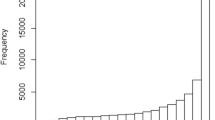Abstract
Ten subjects rendered names for each of 168 novel entities. The entities were quite varied. Naming “strategies” in this task situation were assessed with several dependent measures: (1) the structural form of the name expression (compound noun, lexically modified noun, etc.), (2) the content analysis of the name (i.e., into morphological patterns that directly convey content properties of referents), (3) statistical measures (number of syllables), and (4) comments and ratings elicited from participants. Several general strategies were induced.
Similar content being viewed by others
References
General Mills Corporation (1974).Betty Crocker Cookbook, Golden Press, New York.
Carroll, J. M. (1978). Names and naming: An interdisciplinary review. IBM Res. Rep. RC 7370.
Carroll, J. M. (1979a). Natural strategies in naming. IBM Res. Rep. RC 7533.
Carroll, J. M. (1979b). Complex compounds: Phrasal embedding in lexical structures.Lng. 17:863–877.
Carroll, J. M. (1980a). The role of context in creating names.Discourse processes.3:1–24.
Carroll, J. M. (1980b). “Purpose” in a cognitive theory of reference.Bull. Psychonom. Soc. 16:37–40.
Carroll, J. M., (1980c). Naming and describing insertial communication.Lang. Speech. 23:309–322.
Carroll, J. M., (in press). Creating names for personal files in an interactive computing environment.Int. J. Man-Machine Studies.
Carroll, J. M., and Tanenhaus, M. K. (1975). Prolegomena to a functional theory of word-formation. In Grossman, R., San, J., and Vance, T. (eds.),Papers from the Paresession on Functionalism, Chicago Linguistic Society, Chicago.
Chomsky, N. (1970). Remarks on nominalization. In Jacobs, R., and Rosenbaum, P., (eds.),Readings in English Transformational Grammar, Ginn & Company, Waltham, Mass.
Downing, P. (1977). On the creation and use of English compound nouns.Lang. 53:810–842.
Dreyfus, H. (1972).Symbol Sourcebook, McGraw-Hill, New York.
Faser, B. (1970). Some remarks on the action nominalization in English. In Jacobs, R., and Rosenbaum, P., (eds.),Readings in English Transformation Grammar, Ginn and Company, Waltham, Mass..
Lees, R. B. (1960)The Grammar of English Nominalizations, Indiana University Research Center in Anthropology, Folklore, and Linguistics, Bloomington.
Marzollo, J. and Lloyd, J. (1974).Learning Through Play, Harper and Row, New York.
Osgood, C. E. (1971). Where do sentences come from? In Steinberg, D., and Jakobovitz L., (eds.),Semantics: An Interdisciplinary Reader, Cambridge University Press, Cambridge.
Roeper, T. and Seigel, M. (1978). A lexical transformation for verbal compounds.Ling. Inq. 9:199–260.
Warren, R. E. (1974). Word associations to pictures, figures, symbols, and forms. Columbia University, New York, Unpublished manuscript.
Author information
Authors and Affiliations
Additional information
This is a shortened version of Carroll (1979a).
Rights and permissions
About this article
Cite this article
Carroll, J.M. Creating names for things. J Psycholinguist Res 10, 441–455 (1981). https://doi.org/10.1007/BF01067168
Accepted:
Issue Date:
DOI: https://doi.org/10.1007/BF01067168




